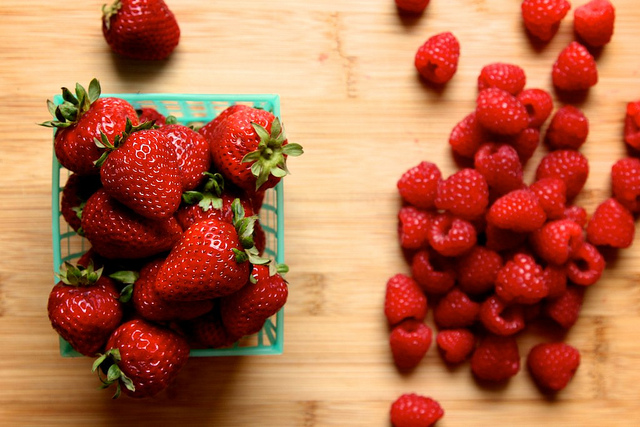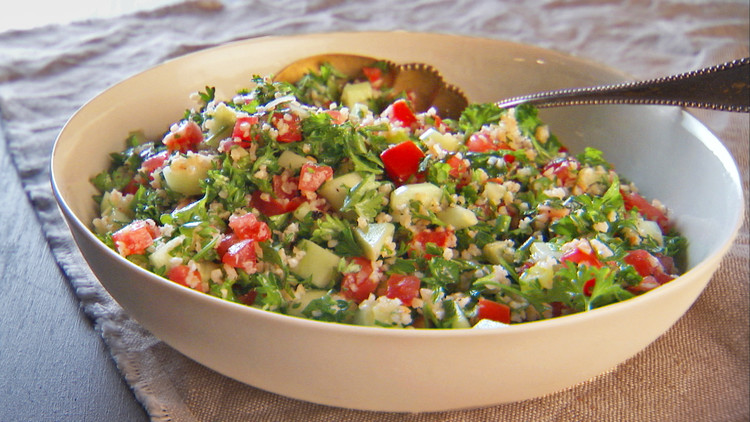Author: Alissa Vandenbark
Heart Health Awareness: Addressing Racial Disparities and Helping Individuals with Heart Disease
National Breakfast Month
There’s no better time to celebrate breakfast than in September during National Breakfast Month! Breakfast is often a low priority meal for some people but eating breakfast has many benefits. Eating breakfast not only helps control weight but it can also help guide us towards healthier eating throughout the day. A healthy breakfast provides your body with what it needs after a night of fasting and can help create a positive impact on your overall health.
It’s that time of year again! Kids are going back to school and it’s important to start each day off right. The American Dietetic Association states that children who eat a healthy breakfast are more likely to have better concentration, be more creative, be more active, and have less sick days from school. A complete breakfast should be a well-balanced meal of protein, carbohydrates, and fats. Having a well-balanced breakfast is vital to helping maintain stamina and prolonging hunger throughout the day.
Healthy Breakfast Ideas:
- Breakfast sandwich made with a whole grain English muffin, turkey bacon, egg whites and low-fat cheese.
- Oatmeal with skim milk topped with fresh fruit
- Whole wheat bread with peanut butter, small banana and a glass of low-fat milk.
- Breakfast parfait made with low-fat yogurt, fruit and low-fat granola.
Yogurt Parfait

Ingredients (1 Serving)
1 (6 oz.) container low-fat yogurt, fruit flavored or vanilla, divided
1/4 c. mixed berries, fresh or frozen, thawed
1 T. granola cereal or plain, unsalted nuts
Directions
Place half the yogurt on the bottom of a glass or paper cup.
Place the mixed fruit on top of yogurt.
Add the rest of the yogurt.
Top with granola cereal or nuts
September 2018 Energy Tip
Happy September to you all. NRG couldn’t be prouder to be associated with and support MANNA. The work MANNA does to provide healthy, medically appropriate meals to those who need them and may otherwise go without, is lifesaving. It fills a void. MANNA was the first recipient of the NRG Gives $100,000 grant back in 2016. NRG Gives is an employee-driven program designed to help local nonprofits that reflect the values and programs important to our employees. Ultimately the public votes on who should receive the grant, but employees nominate and select all the finalists. So thank you to MANNA and all its donors and volunteers for the amazing work you do.
Each month, as part of NRG’s communications sponsorship, NRG will be providing simple energy related tips that may potentially reduce your energy usage, but may also help reduce your carbon footprint and potentially limit the stress on our grid.
With September being National Preparedness Month, we thought it best to start with some simple ways to ensure you are ready for an emergency, particularly power outages caused by storms. The tips below come from our friends and colleagues at Goal Zero, an NRG company.
BEFORE THE STORM
- Identify a safe area to take refuge and secure any outdoor items that could become airborne during the storm.
- Develop and practice your family communication plan. Identify an out-of-state contact that everyone can call if the family gets separated and designate a familiar emergency meeting location.
- Review your insurance coverage and take pictures of your home, building and/or office – inside and out.
- Gather necessary supplies: water, First Aid Kit, flashlights, tarps, plastic bags, tape, sandbags, shutters, plywood, hand tools, generator, brooms, mops, towels and batteries.
- Fully charge cell phones, laptops, portable power stations and any other electronics, and top off your vehicle’s gas tank.
- Ensure a supply of water for sanitary purposes, such as cleaning and flushing toilets. Fill the bathtub and other large containers with water.
DURING THE STORM
- Stay indoors during the storm and away from windows and glass doors.
- Take refuge in a small interior room, closet or hallway on the lowest level.
- Bring along books, tablets, or toys to keep children occupied – don’t forget to bring backup power and lights along to keep devices charged up.
- Keep curtains and blinds closed in case windows shatter from high winds or debris. Do not be fooled if there is a lull; it could be the eye of the storm – winds will pick up again.
AFTER THE STORM
- If separated from your family, use your family communications plan or contact FEMA or the American Red Cross.
- Keep away from loose or dangling power lines and report them immediately to your local utility company.
- Walk around the outside of your home and check for any structural damage. Take pictures of any damage. If you have any doubts about safety, have your home inspected by a qualified building inspector or structural engineer before entering.
- Stay out of any building if you smell gas, if floodwaters remain around the building, or if your home was damaged by fire and the authorities have not declared it safe.
- Never use a gasoline generator inside homes, garages, crawlspaces, sheds or similar areas, even when using fans or opening doors and windows for ventilation. Deadly levels of carbon monoxide can quickly build up in these areas and linger for hours, even after the generator is turned off. Consider using a gasoline-free portable power station to supply backup power to your home instead.
- If you are unable to return home and have immediate housing needs, text SHELTER + your ZIP code to 43362 (4FEMA) to find the nearest shelter in your area (example: shelter 77005).
National Watermelon Day

Treat yourself to some delicious watermelon on August 3rd, National Watermelon day! Watermelon is a tasty summer snack that will also help keep you hydrated. Watermelon is fat free and low in calories, with 2 cups of diced watermelon providing only 80 calories. Nutritionally speaking, watermelons are packed with vitamins A and C, Lycopene, Potassium, and amino acids. In Pennsylvania, watermelons are in peak season August through October, so now is the perfect time to learn some fun ways to incorporate watermelons into your day.
The many ways to enjoy a watermelon
Watermelons are delicious as is, however if you want to mix it up, they can be juiced, thrown into a smoothie, grilled, or frozen. If you are feeling crafty, they can be made into a beautiful carving before consumption. Watermelons, along with some other fruits, have a high water content (about 92%). Whether you plan on going to the beach, picnic, or to a baseball game, watermelons are the perfect snack, as they will help keep you hydrated!
Tips on choosing your perfect watermelon
Believe it or not, there are many things to look for when choosing watermelons. Did you know that there are “boy” and “girl” watermelons, each looking different, and having a different taste as well? “Boy” watermelons are longer, and have a higher water content (best for juicing). “Girl” watermelons are more round, and are sweeter. In general, when selecting watermelons, make sure you pick it up and inspect it. The heavier the watermelon, the better! Turn the watermelon over, and look for a creamy, yellow spot on the bottom, this means the melon is ripe. If it is a light green, it is not ripe enough. Give the watermelon a good squeeze to make sure it is nice and firm and contains no soft spots. Ripe, cut watermelon can be stored in a container with a lid in the refrigerator for up to one week. Unripe watermelons can be stored at room temperature for up to two weeks, or until ripe. When preparing watermelon, make sure you give the whole watermelon a thorough rinse before cutting in half. Prepare as desired, and enjoy!

Healthy, Hydrating Watermelon Smoothie
Serves: 2
Ingredients:
1 ½- 2 cups fresh watermelon, cubed
1 cup fresh or frozen strawberries
½ banana fresh or frozen (frozen will add a creamier taste)
½ cup yogurt (optional)
Juice of 1 lime or lemon
*Tip-Add ice cubes, if you are using fresh fruit, instead of frozen.
Instructions:
- Add all ingredients to a blender, blend until creamy and smooth.
- Taste, and add ingredients as needed (add more banana for a sweeter option; add more watermelon for a more intense watermelon flavor, etc.)
- Top with garnish of choice! (Fresh strawberries, chia seeds, lemon slice, etc.). Enjoy!
National Berries Month
July: National Berries Month!
Fresh, fun, and flavorful!
Kick off the month of July with a handful of your favorite berries! July celebrates “National Berries Month” and includes all berries including blackberries, strawberries, blueberries, and raspberries. Since they are in season, July is the perfect time to start incorporating berries into your daily routine!
The many reasons to consume berries:
Berries pack a nutritional punch in each bite. They are highly nutritious, containing many vitamins and minerals. Did you know that one cup of strawberries provides a whopping 150% of the Recommended Dietary Intake of Vitamin C? Berries are also loaded with antioxidants. Antioxidants may help boost immune function, fight inflammation, and protect against cancer and heart disease. Another great thing about berries is they are a good source of fiber. Consuming fiber helps you to feel fuller longer and promotes digestive health.
Tips on how to include more berries into your diet:
Luckily, this is an easy and delicious step! Feel free to simply add berries to the foods you already eat. For example, try adding some strawberries to a bowl of yogurt or oatmeal in the morning. At lunch, sprinkle some blackberries or blueberries on a salad with a grilled protein of your choice (chicken, shrimp, tofu). For a tasty dessert, try adding a berry of your choice to some Greek yogurt, ice cream, or frozen yogurt. Berries are also delicious by themselves. Have fun with it! Try mixing a variety of berries together to make a beautiful multicolored berry salad.
What to look for when shopping:
This is prime time to shop for berries since they are in season. Take advantage of local farmers’ markets where you can buy fresh, locally grown produce. Look for firm, plump, and full-colored berries. Avoid buying any bruised or oozing berries. If you are buying berries in a container, make sure to check the berries at the bottom, too. Before preparing or eating, wash berries under clean, running water, then let dry. Consume right away, or store in the refrigerator. For maximum flavor and freshness, use within 1-3 days.
Tip: If you participate in SNAP, for every $5 of food stamps spent on participating farmers’ markets, you will receive $2 in Philly Food Bucks, which can be used to purchase more fresh fruits and vegetables! Learn more at: http://thefoodtrust.org/what-we-do/foodbucks
Try this at your 4th of July BBQ!
Strawberry Yogurt “Cake”

Serves 8 | Serving Size: 1/8th of a cake
Recipe from: foodandhealth.com
Ingredients:
- 4 cups of sliced fresh strawberries
- 1 cup fresh raspberries
- 1 cup nonfat plain Greek yogurt
Garnish:
- Shaved chocolate (use a potato peeler)
- Julienned fresh mint
Directions:
- Place the berries in a large mixing bowl and lightly mash them with a ladle or wooden spoon.
- Place the yogurt in a different large bowl. Top the yogurt with the mashed berries, then press down very well to compact the berries.
- Invert the bowl onto a plate.
- Garnish the “cake” with shaved chocolate and mint and serve cold.
National Dairy Month
Did you know that June is National Dairy Month? It was created to promote milk intake during the summer months so that everyone would get the health benefits of dairy year-round. Dairy products are a great addition to any healthy diet and are packed with calcium, potassium, and fortified vitamin D. Calcium is important for bone health, wound healing, maintaining a healthy blood pressure, and muscle contractions. High potassium intake is associated with reduced risk of stroke, heart disease, and high blood pressure. Vitamin D is important for the formation, growth, and repair of bones. A standard cup of 1% milk contains about 102 calories, 2.4 grams of fat, 8.2 grams of protein, 10% daily value of potassium, 32% daily value for vitamin D, and about a 1/3 daily value of calcium.
According to the dietary guidelines evidence rating, there are studies that show milk products have been linked to improved bone health, especially among children and adolescents. In addition to bone health, there is some research that shows dairy intake is linked to better weight management, reduced hyperglycemia, and decreased hypertension.
The current recommendation for dairy is 3 cups per day for people ages 9 and over. Many Americans fall short on this recommendation, with a large percentage due to lactose intolerance. There are about 30 to 50 million Americans who are lactose intolerant. Yogurt, which contains less lactose per serving than milk, may be a more easily digestible alternative for some. There are also many lactose-free dairy products available such as Lactaid, soy milk, and almond milk. When choosing milk, both the American Heart Association and DASH diet recommends low-fat dairy for optimum health. For Children under the age of 2, whole milk is recommended for growth and development.
Tips for increasing dairy:
• Make oatmeal with skim or 1% milk instead of water
• Eat yogurt as a snack, instead of chips
• Add skim or 1% milk to coffee
• Try low-fat yogurt parfait as dessert
• Add low fat or nonfat cheese to vegetables, or mix fresh fruit with low-fat cheese
• Add one of milk to the meal instead of juice or soda
• Use yogurt as an alternative to mayonnaise
Breakfast Smoothie Recipe
• Prep. Time 5 mins
• Yields 2 to 3 servings

Ingredients
1 banana, peeled and cut into chunks
1 cup (250 mL) plain low-fat yogurt or low-fat fruit-flavored yogurt
1 cup (250 mL) 1% milk
1 cup (250 mL) mixed fruit, (fresh or frozen)
1 tbsp (15 mL) honey
1 tsp (5 mL) vanilla extract
Preparation
In a blender, or in a tall cup using an immersion blender, combine banana, yogurt, milk, mixed fruit, honey and vanilla extract and puree until smooth. Pour into chilled glasses and serve immediately.
It’s National Salad Month
Trying to pack in some delicious nutrition without packing on the extra calories?
Salad is a convenient way to use the ingredients or leftovers you have on hand, and the recipes are limitless. Fruits and vegetables are naturally low in calories and fat, and offer a wide range of vitamins and minerals, while whole grains, nuts/seeds, and protein will help to keep you full and satisfied.
To get the most out of your salad greens and other produce, store them in the middle of a clean fridge away from the doors, with plenty of room for air circulation. To preserve greens, keep them stored in a dry, paper towel lined container. Keep fresh herbs and celery stored in water to make these last longer as well. Lastly, keep ethylene gas-producing fruits such as bananas, avocados, tomatoes and melon away from other produce; ethylene is a naturally occurring gas, but it can make some produce spoil faster.
When it comes to making healthy choices, salads can be a great option, but they don’t have to be boring! If you’re looking to swap out your salad staples for something new, give these mix-ins a try:
Vegetables – Asparagus, beets, mushrooms, corn, olives, radishes, carrots, broccoli, heart of palm, artichoke hearts, peas (try your vegetables grilled, marinated, raw, or pickled!)
Fruit (fresh and dried) – Oranges, pears, apple, berries, pomegranate, mango, dried cranberries, dried cherries
Whole Grains – Rice, bulgur, quinoa, farro, couscous
Nuts & Seeds – Walnuts, pepitas, sesame seeds, almonds
Fresh Herbs – Basil, mint, parsley, dill, chives, cilantro
Vegetarian Protein – Crispy baked chickpeas, black beans, lentils, edamame, tofu, seitan
Seafood – Salmon, tuna, shrimp, scallops
Meat – Chicken, turkey, steak (slice up some leftovers!)
Cheese – Parmesan, goat cheese, feta, mozzarella, cottage cheese
Other – Hummus, salsa, micro-greens, seaweed, avocado mash
Tabbouleh Salad Recipe

Ingredients:
- 1 cup uncooked bulgur
- 3/4 cup chopped cucumber
- 3/4 cup chopped tomato
- 1/2 cup chopped fresh parsley
- 1/4 cup chopped fresh mint leaves
- 1/4 cup sliced green onions or 2 tablespoons finely chopped sweet onion
- 1 clove garlic, finely chopped
- 1/4 cup olive oil
- 1/4 cup lemon juice
Prepare bulgur according to package directions.
After the bulgur is ready, mix together bulgur, cucumber, tomato, parsley, mint, onions, and garlic.
In a separate bowl, whisk together the olive oil and lemon juice. Then combine with the other ingredients, mixing well.
Refrigerate and let chill for 2 hours before serving for the flavors to meld. Season with salt and pepper, to taste, before serving.
Spring into April with Fresh Fruits and Vegetables!
Spring is finally here and so are all of the delicious seasonal fruits and vegetables. Fresh produce is a great source of vitamins and minerals that are important for our health. In addition, fruits and vegetables provide powerful antioxidants, which have been shown to have protective effects against chronic illnesses such as heart disease and cancer. Some additional nutrients found in fruits and vegetables include:
Vitamin C: powerful antioxidant that helps the body to fight the effects of cancer-causing free radicals, helps form blood vessels, muscles and collagen in bones
Vitamin A: important for vision, growth, cell division, reproduction, immunity
Vitamin K: regulates normal blood clotting, supports cell growth and bone metabolism
Folate: essential for cell growth and nervous system functioning, fetal nervous system development
Fiber: promotes regular bowel movements, speeds up elimination of waste through the colon, improves digestive health
So what fruits and vegetables are in season this Spring?
Shopping for fruits and vegetables that are in season is always a great option. Locally grown fruits and vegetables are harvested at their peak, which means you are getting the freshest produce that are full of flavor and nutrients. Try stopping by your local farmers market to find great sources of seasonal produce, or check out which fruits and vegetables are in season before you head to the grocery store!
Spring seasonal fruits and vegetables:
- Apples
- Avocado
- Broccoli
- Cabbage
- Carrots
- Collard Greens
- Garlic
- Peas
- Radishes
- Spinach
- Strawberries
- Turnips
Parmesan Carrots with Lemon-Parsley Dressing

Ingredients
- 1/2 cup water
- 1/4 cup chopped shallots
- 14 ounces medium carrots, cut diagonally into 1 1/2-in. pieces (about 2 1/2 cups)
- 2 tablespoons olive oil
- 3 tablespoons chopped fresh flat-leaf parsley
- 1 1/2 tablespoons fresh lemon juice
- 2 teaspoons pine nuts, toasted
- 1/4 teaspoon black pepper
- 3 tablespoons shaved Parmesan cheese
How to Make It
Combine 1/2 cup water, shallots, and carrots in a medium skillet over medium-high; bring to a boil. Reduce heat to low and simmer, partially covered, 6 minutes or until carrots are tender. Increase heat to medium-high and cook, uncovered, 4 minutes or until liquid evaporates. Add oil; cook 4 minutes or until carrots are lightly browned, stirring occasionally. Stir in parsley and remaining ingredients.
National Nutrition Month 2018
Get Ready Because March is National Nutrition Month®!
The theme of National Nutrition Month this year is “Go Further with Food.” Whether it is starting your day off right with a healthy breakfast, planning meals and snacks ahead of time to reduce food waste, or learning how to read a nutrition facts label, the foods you choose daily can really make a difference! There are several ways to explore a healthy lifestyle. Each day, during the month of March, challenge yourself to become a healthier you and experiment with ways you can incorporate a healthy lifestyle into your everyday life. National Nutrition Month® is encouraging you to experience the benefits of healthy eating habits and cutting back on food waste as you go further with food!
Here is what you can do to go further with food:
• Include a variety of fresh healthy foods from all of the food groups daily.
• Plan your meals ahead of time to reduce food waste.
• Use leftover ingredients to prepare meals for later in the week.
• Use good food safety practices to prevent food borne illness.
• Be mindful of portion sizes; eat the amount that’s right for you!
Tips while challenging yourself to go further with food:
• Are your favorite fruits and vegetables not in season this March? Don’t sweat it! Frozen fruits and vegetables are just as nutritious as fresh fruits and vegetables and can be stored longer. Challenge yourself to incorporate more of these foods into your daily diet.
• Plan your meals for the week before you go to the grocery store and make a list. Sticking to your list will eliminate impulse buys at the store so that you won’t purchase more ingredients than you need that could potentially go to waste.
• Unsure what to do with your leftovers from dinner? Try incorporating them into lunch for the next day or using them as an ingredient in another dish.
• Use sanitary practices while preparing food, avoid cross contamination. Make sure to use a thermometer if necessary to prevent any food borne illness!
• MyPlate is a great reference to use when preparing a meal. Use the MyPlate guidelines to help design your plate
Instead of the potato chips, start off National Nutrition Month® with this delicious and easy baked zucchini chips recipe!

Ingredients:
1/4 cup milk
3/4 cup freshly grated Parmesan cheese
1/2 cup breadcrumbs
1/2 tsp Kosher salt
1/8 tsp freshly ground black pepper
4 large zucchini, sliced into 1/4-inch thick rounds
Directions:
1) Preheat oven to 425°F. Line a baking sheet with aluminum foil and coat with non-stick cooking spray.
2) For the chips, pour milk in a small bowl. In a medium bowl, combine Parmesan, breadcrumbs, salt and pepper. Working one at a time, dip zucchini rounds in milk and then coat in the Parmesan mixture.
3) Lay crusted slices on prepared baking sheet and bake for 20 minutes. Flip zucchini rounds and continue to bake another 10 minutes. Sprinkle with Kosher salt and serve.










